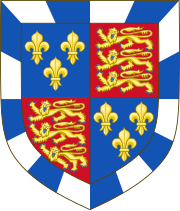
Back Dug Beaufort (Bro-Saoz) Breton Duke of Beaufort German Δούκας του Μπωφόρ (Αγγλία) Greek Ducado de Beaufort Spanish Duc de Beaufort (Angleterre) French Duca di Beaufort Italian ボーフォート公爵 Japanese Hertog van Beaufort Dutch Książę Beaufort Polish Duque de Beaufort Portuguese
| Dukedom of Beaufort | |
|---|---|
  Quarterly, 1st and 4th, azure three fleurs-de-lys or (for France); 2nd and 3rd, gules three lions passant guardant in pale or (for England), all within a bordure compony argent and azure | |
| Creation date | 2 December 1682 |
| Created by | Charles II |
| Peerage | Peerage of England |
| First holder | Henry Somerset, 3rd Marquess of Worcester |
| Present holder | Henry Somerset, 12th Duke of Beaufort |
| Heir apparent | Henry Robert FitzRoy Somerset, Marquess of Worcester |
| Remainder to | 1st Duke's heirs male of the body lawfully begotten |
| Subsidiary titles | Marquess of Worcester Earl of Worcester Earl of Glamorgan (courtesy) Viscount Grosmont (courtesy) |
| Seat(s) | Badminton House (since the 17th century) |
| Former seat(s) | Raglan Castle (until 1646) |
| Motto | Mutare vel timere sperno (Latin for 'I scorn to change or to fear')[1] |
Duke of Beaufort (/ˈboʊfərt/)[2] is a title in the Peerage of England. It was created by Charles II in 1682 for Henry Somerset, 3rd Marquess of Worcester, a descendant of Charles Somerset, 1st Earl of Worcester, legitimised son of Henry Beaufort, 3rd Duke of Somerset, a Lancastrian leader in the Wars of the Roses. The name Beaufort refers to a castle in Champagne, France (now Montmorency-Beaufort). It is the only current dukedom to take its name from a place outside the British Isles.[citation needed]
The Dukes of Beaufort descend in the male line from the House of Plantagenet through John of Gaunt, son of Edward III. This statement was challenged after the analysis of the Y chromosomal DNA of the remains of Richard III. Most living male heirs of the 5th Duke of Beaufort were found to carry a relatively common Y chromosome type, which is different from the rare lineage found in Richard III's remains. The instance of false paternity could have occurred anywhere in the numerous generations separating Richard III from the 5th Duke of Beaufort.[3] The break also could have occurred with Richard III's grandfather Richard of Conisburgh, whose paternity has been called into question although he was acknowledged by his father.
The Beaufort Castle was in possession of John of Gaunt, and the surname Beaufort was given to Gaunt's four legitimised children by his mistress and third wife, Katherine Swynford. This was the foundation of the House of Beaufort, Dukes of Somerset. A descendant of the Beauforts through his mother was Henry VII of England. Charles Somerset, 1st Earl of Worcester,KG (c. 1460 – 15 March 1526), was the bastard son of Henry Beaufort, 3rd Duke of Somerset by his mistress Joan Hill.[4]
The Duke of Beaufort holds two subsidiary titles – Marquess of Worcester (created 1642) and Earl of Worcester (created 1514). The title of Marquess of Worcester is used as a courtesy title by the duke's eldest son and heir. The title of Earl of Glamorgan is used by the eldest son of the heir apparent to the dukedom. The Earl of Glamorgan's eldest son is known as Viscount Grosmont. The Earldom of Glamorgan and Viscountcy of Grosmont derive from an irregular creation in 1644 by Charles I in favour of Edward Somerset, who later succeeded his father as 2nd Marquess of Worcester.
Although the Earldom of Glamorgan and Viscountcy of Grosmont were not recognised as substantive titles at the restoration of Charles II, because of irregularities in the patent of creation, they have nevertheless continued to be used as convenient courtesy titles in order to distinguish the bearer from the Marquess of Worcester as heir apparent, the Earldom of Worcester not being distinctive enough for this purpose. All subsidiary titles are in the Peerage of England.
Field Marshal The Lord Raglan, born Lord FitzRoy Somerset (1788–1855), was the youngest son of the fifth duke.
The family seat was once Raglan Castle in Monmouthshire, but as of 2017[update] was Badminton House near Chipping Sodbury in Gloucestershire. The principal burial place of the Dukes and Duchesses of Beaufort is St Michael and All Angels' Church, Badminton.
Following the creation of the dukedom, each successive duke has served as Master of the Duke of Beaufort's Hunt, a foxhound pack kenneled on the Badminton Estate.
- ^ Woods, Judith (10 December 2013). "Lord Edward Somerset: a fine pedigree counts for nothing". The Daily Telegraph. Retrieved 3 December 2016.
- ^ Wells, John C. (2008). Longman Pronunciation Dictionary (3rd ed.). Longman. ISBN 978-1-4058-8118-0.
- ^ "Richard III's DNA throws up infidelity surprise". BBC News. 2 December 2014. Retrieved 18 August 2017.
- ^ Mosley, Charles, ed. (2003). Burke's Peerage, Baronetage & Knighthood (107 ed.). Burke's Peerage & Gentry. p. 301. ISBN 0-9711966-2-1.